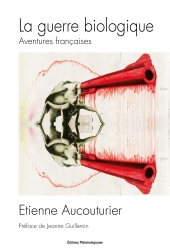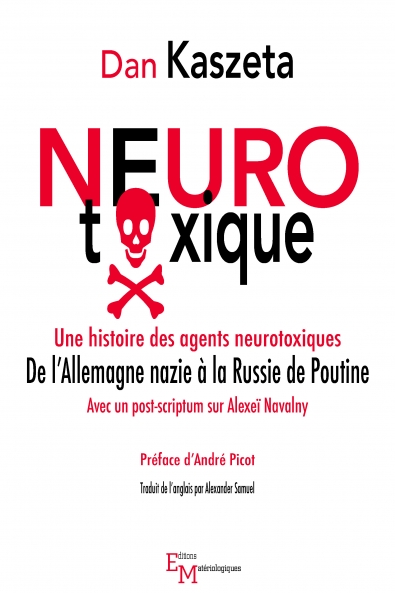No products
Prices are tax included
Product successfully added to your shopping cart
There are 0 items in your cart. There is 1 item in your cart.
News
Catalogue
Biological Warfare – Another French Connection, is the first book to summarize the history of France’s biological warfare programs. Highlighting the complex and always secret conceptual genesis of the notion of biological warfare in France, Etienne Aucouturier shows that the contemporary institutional separation between chemical and biological weapons converges in reality on the same project, that of providing armies with the capability to selectively target living organisms or physiology by means of surgical strikes that use poisons or pathogens.
From the invention of microbial aerosols before the First World War, to the last chemical weapons tests in the Algerian desert in the 1970s, the book documents the scientific and technical research conducted to achieve this military capability. It reports on the constant interaction between the military and civil biomedical research spheres in France during the 20th century, while at the same time retracing the history of the debates between politicians, soldiers and scientists on the subject of biological warfare, and reveals how this important aspect of the military strategy of the last three French Republics was discussed at the highest levels of state, scientific and military hierarchies. Drawing on a large number of archival documents that have subsequently become difficult to consult, Aucouturier demonstrates the way in which these secret interactions gave rise to a sort of covert agreement between France’s biomedical institutions and its military strategists.
By reversing the order of current analysis - which dissociates, in principle, chemical and biological weapons - and focusing on the military's goal of selectively targeting the living, the book also provides a dynamic and historically justified conceptual framework that permits the reader to consider, and to fear, the possible future forms that biological warfare may take.
| Authors | Etienne Aucouturier |
| Title | La guerre biologique |
| Subtitle | Aventures françaises |
| Edition | 1re |
| Published | Juin 2017 |
| Foreword | Jeanne Guillemin |
| ISSN | En cours |
| ISBN | 978-2-37361-118-2 |
| eISBN | 978-2-37361-119-9 |
| Support | papier et ebook |
| EAN13 paperback | 9782373611182 |
| EAN13 ebook | 9782373611199 |
| EAN13 ebook | 9782373611267 |
| Number of pages | 240 |
| Dimensions | 16,4x24 cm |
| Paperback price | 23 € |
| Prix ebook ePub | 13,99 € |
Remerciements et dédicaces (page 3)
Liste des sigles (page 5)
Préface de Jeanne Guillemin (page 7)
Avant-propos (page 17)
Introduction (page 23) La guerre biologique : aventures françaises
1] Définitions
2] Plan du livre
3] Éléments contextuels et contraintes méthodologiques
Chapitre 1 (page 37) Guerre microbienne, guerre bactériologique
1] Quelques formes élémentaires d’épidémies provoquées
2] Guerre microbienne et guerre bactériologique
3] La Première Guerre mondiale fut-elle aussi « bactériologique » ?
Chapitre 2 (page 55) Premières aventures françaises
Chapitre 3 (page 65) La création d’un programme français d’armement biologique (1921-1940)
1] La poudrerie du Bouchet
2] La menace allemande
Chapitre 4 (page 81) Le sort du programme français pendant la Seconde Guerre mondiale
1] Le SIPN et l’Omnium des produits azotiques
2] La débâcle et la Station d’essai du Bouchet
3] La guerre biologique : en un (nouveau) sens populationnel
Chapitre 5 (page 93) La Libération et la Commission médicale de défense contre la guerre moderne
Chapitre 6 (page 107) Le savoir-faire allemand et « l’odieuse contrainte »
1] Le point de vue de la victime et « l’odieuse contrainte » de penser en agresseur
2] Aérosols et nuages : « Faire la pluie et le beau temps »
3] Un vaccin contre la radioactivité ?
Chapitre 7 (page 121) Vers une défense biochimique
1] La fin (provisoire) de la guerre « bactériologique »
2] Le Commandement des armes spéciales (CAS)
Chapitre 8 (page 135) La Commission des études et expériences chimiques et bactériologiques
1] Destruction massive et dommages aux écosystèmes
2] Statistiques et populations
Chapitre 9 (page 147) Destruction massive et réaction en chaîne
1] Provoquer des résultats bien définis dans l’espace et dans le temps
2] Des armes de pourrissement
3] Les vecteurs mécaniques : fusées et obus
Chapitre 10 (page 163) Vers un réarmement : 1959-1965
1] Un rapprochement avec les États-Unis et les Pays-Bas
2] Une relance lente
3] Privilégier les incapacitants ?
Chapitre 11 (page 179) Réorganisations et privatisations
1] Un recours massif à la sphère privée
2] Petits et gros animaux
Chapitre 12 (page 191) Les essais du Sahara et la Sodeteg
1] Aromates, épices et B2-Namous
2] Les moutons de la Sodeteg
3] Lampadaire et Marjolaine
Chapitre 13 (page 207) Le secret d’État et la loi
1] Le rôle de la Sodeteg
2] Qu’en fut-il de la guerre biologique en France après 1972 ?
3] Composer avec la loi : offense et prophylaxie
4] Le troublant destin de la Sodeteg
Conclusion (page 229)
Index (page 231)
Recension de Nicolas Chevassus-au-Louis sur Médiapart, 25 juillet 2017 (payant).
Entretien sur Radio libertaire, le 23 octobre 2017 (90 minutes). Cliquer ici pour écouter.
Recension dans Le Monde diplomatique, avril 2018.
Le Soir d'Algérie, novembre 2018.

| Download |
CharlieHebdo-Aucouturier (2.05M)
Article d'Antonio Fischetti dans Charlie Hebdo, n° 1301 du 28 juin 2017 Aucouturier-SetA nov2017 (970.79k)
Recension dans "Sciences et Avenir", novembre 2017, p. 124. |



